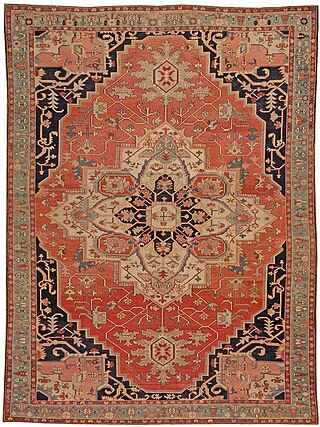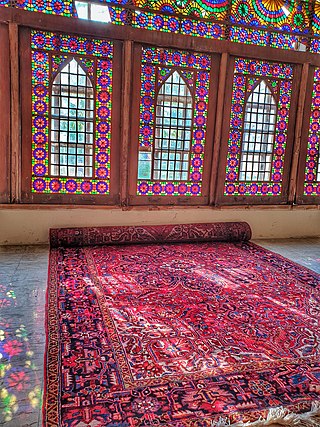
A carpet is a textile floor covering typically consisting of an upper layer of pile attached to a backing. The pile was traditionally made from wool, but since the 20th century synthetic fibers such as polypropylene, nylon, or polyester have often been used, as these fibers are less expensive than wool. The pile usually consists of twisted tufts that are typically heat-treated to maintain their structure. The term carpet is often used in a similar context to the term rug, but rugs are typically considered to be smaller than a room and not attached to the floor.

A Persian carpet, Persian rug, or Iranian carpet is a heavy textile made for a wide variety of utilitarian and symbolic purposes and produced in Iran, for home use, local sale, and export. Carpet weaving is an essential part of Persian culture and Iranian art. Within the group of Oriental rugs produced by the countries of the "rug belt", the Persian carpet stands out by the variety and elaborateness of its manifold designs.

A kilim is a flat tapestry-woven carpet or rug traditionally produced in countries of the former Persian Empire, including Iran, but also in the Balkans and the Turkic countries. Kilims can be purely decorative or can function as prayer rugs. Modern kilims are popular floor coverings in Western households.

Gabbeh or gabba carpets are a traditional variety of Persian carpet. Gabbeh is known as gava in Kurdish and Luri and is also called khersak (خرسک) in Bakhtiari, literally meaning a "bear's cub". Traditionally a sleeping rug, a gabbeh is a hand-woven pile rug of coarse quality and medium size characterized by an abstract design that relies upon open fields of color and a playfulness with geometry. This type of rug is popular among the populations of the Zagros Mountains of Iran, including Kurdish, Luri and Qashqai people. The gabbeh is usually crafted by women.

Uşak carpets, Ushak carpets or Oushak Carpets are Turkish carpets that use a particular family of designs, called by convention after the city of Uşak, Turkey – one of the larger towns in Western Anatolia, which was a major center of rug production from the early days of the Ottoman Empire, into the early 20th century.

A Shiraz carpet is a type of Persian rug made in the villages around the city of Shiraz, in the Iranian province of Fars.

A Tabriz rug or carpet is a type in the general category of Persian carpets from the city of Tabriz, the capital city of East Azerbaijan province in northwest of Iran. It is one of the oldest rug weaving centers and makes a huge diversity of types of carpets. The range starts at Bazaar quality of 24 raj and on up to the incredibly fine 110 raj. Raj is the unit of knot density. It shows the rigidity of the rug which based on the number of strings used for the foundation of the rug. Strings materials are usually made of cotton or silk which is used for very fine rugs.
An oriental rug is a heavy textile made for a wide variety of utilitarian and symbolic purposes and produced in "Oriental countries" for home use, local sale, and export.

Heriz rugs are Persian rugs from the area of Heris in northwest Iran, northeast of Tabriz. Such rugs are produced in the village of the same name in the slopes of Mount Sabalan. Heriz carpets are durable and hard-wearing and they can last for generations. 19th century examples of such carpets are often found on sale by major auction houses in United States and Europe. Part of the reason for the toughness of Heriz carpets is that Mount Sabalan sits on a major deposit of copper. Traces of copper in the drinking water of sheep produces high quality wool that is far more resilient than wool from other areas. The Heris Carpet is the only carpet in the world where stories of the Old times are woven.

Anatolian rug or Turkish carpet is a term of convenience, commonly used today to denote rugs and carpets woven in Anatolia and its adjacent regions. Geographically, its area of production can be compared to the territories which were historically dominated by the Ottoman Empire. It denotes a knotted, pile-woven floor or wall covering which is produced for home use, local sale, and export, and religious purpose. Together with the flat-woven kilim, Anatolian rugs represent an essential part of the regional culture, which is officially understood as the Culture of Turkey today, and derives from the ethnic, religious and cultural pluralism of one of the most ancient centres of human civilisation.

The Ahar rug, also called Ahar carpet, is a type of Persian carpet made in the town of Ahar in Ahar County is the capital of Karadag Khanate in Iran.

In 1292, Marco Polo was the first to make mention of the Konya carpets in writing when he called them the most beautiful in the world. Konya carpets are named for the region in which they were made. Renamed from the Greek “Iconium” when the Seljuk Sultans of Rum made it their capital, Konya is one of the largest, oldest and continuously occupied cities in Asia Minor.

Armenians wove Lilihans in Lilihan village in what used to be called Kamareh district in Iran. The term Lilihan is better known in the US, in Europe it is not as widely used.

Sultanabad rugs and carpets are floor coverings of distinctive design made in Arak, Iran since the 19th century.

Caucasian carpets and rugs are primarily made in villages, rather than in cities. They are made from materials particular to individual tribal provinces, the rugs of the Caucasus normally display bold geometric designs in primary colors. Styles typical to the Caucasus region are Daghestan, Verne, Shirvan, Ganja, Kazakh, Karabagh, and Quba rugs. Several carpet styles from contemporary northwestern Iran also fall largely into this bracket, such as the Ardabil rugs.
A Sarouk rug is a type of Persian rug from Markazi Province in Iran. Sarouk rugs are those woven in the village of Saruk and also the city of Arak and the surrounding countryside.
Varamin carpets and rugs or Veramin carpets and rugs are carpets and rugs woven in city of Varamin and its surrounding area, southeast of Tehran. Many rug and carpet experts see Varamins as being among those Persian carpets most authentic in terms of traditional style and motif.

The Bakhtiari rug, along with other weavings, is a major artform of the Bakhtiari tribe, located in Chahar Mahaal and Bakhtiari, Iran. Since the early 19th century, Bakhtiari rugs have been exported around the world.
Afshar is a handwoven rug style produced by the Turkic Afshar tribe, a semi-nomadic group principally located in the mountainous areas surrounding the modern region of Iranian Azerbaijan. An additional population of Afshar tribes-people is located in the Kuchan area in Razavi Khorasan Province of Iran and city of Kerman. Carpets in the Afshar style are known for their stylized floral geometric designs, tribal artistry, and a characteristic palette of rust and blue color tones.

The Oriental Carpet Manufacturers (OCM) was a London-based company involved in the production of, and trade with, Oriental carpets. Established in 1907/8 in Istanbul, the company set up and controlled their own carpet manufactures in the central Anatolian region around the town of Konya, and from 1911 onwards, in the Hamadan Province in northwestern Iran. In 1983 it was sold, and merged with one of its former affiliates, the Eastern Kayam Company. From 1924 until 1948, OCM was led by Arthur Cecil Edwards, who, after retiring, wrote a text book on Persian Carpets, which is still in print today.
















